Legal Principles of Contracts: Case Studies and Practical Examples
VerifiedAdded on 2020/04/01
|7
|1865
|454
Homework Assignment
AI Summary
This assignment delves into the core principles of contract law, examining the essential elements required for a binding agreement, including offer, acceptance, consideration, mutuality of obligations, and capacity. It differentiates between formal and informal contracts, discussing the significance of written agreements and their enforceability. The assignment further explores the intention of parties in contract formation, illustrated through a lottery ticket scenario, and clarifies the roles of agents versus independent contractors, highlighting their legal implications. The document provides definitions and examples, supported by case law and academic references, offering a comprehensive understanding of contract law concepts.
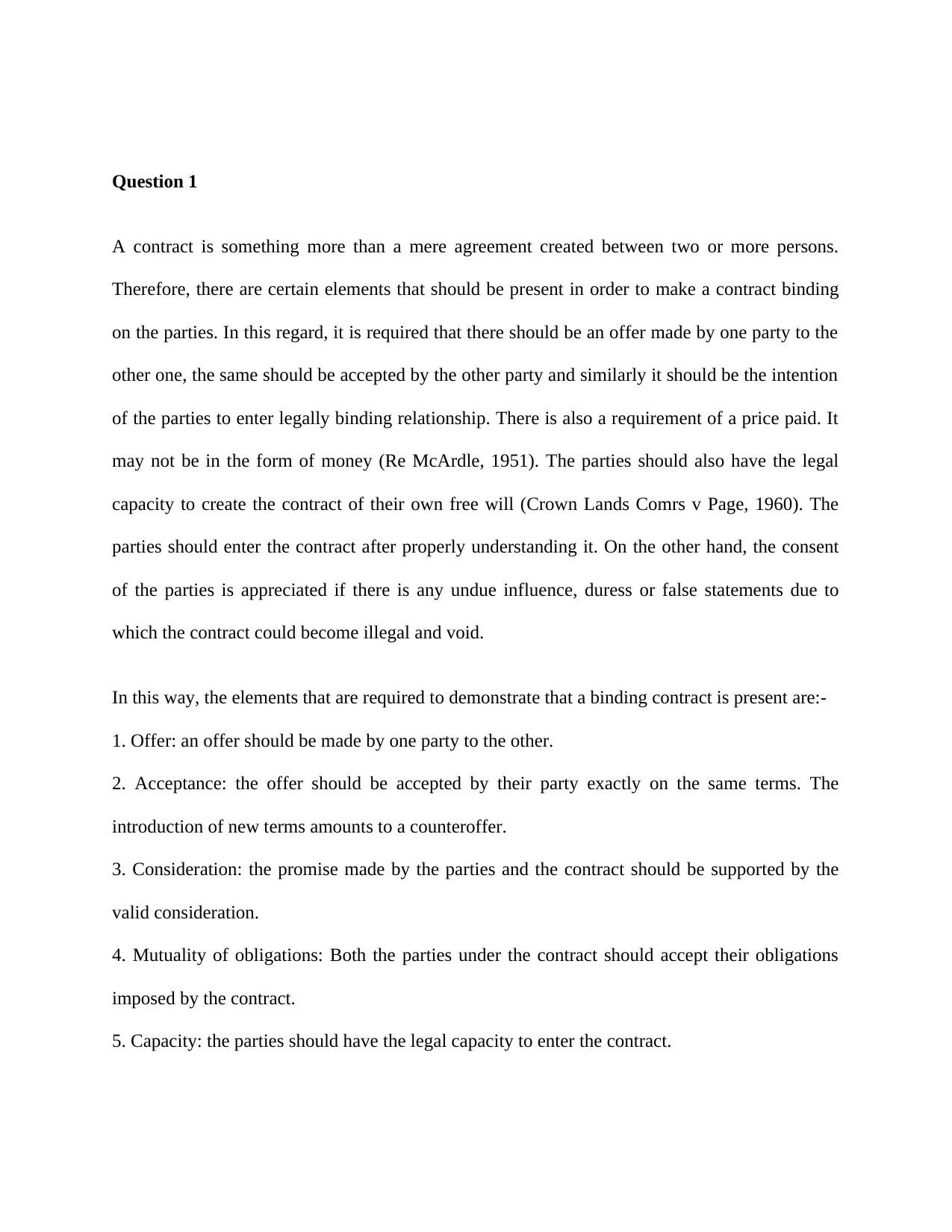
Question 1
A contract is something more than a mere agreement created between two or more persons.
Therefore, there are certain elements that should be present in order to make a contract binding
on the parties. In this regard, it is required that there should be an offer made by one party to the
other one, the same should be accepted by the other party and similarly it should be the intention
of the parties to enter legally binding relationship. There is also a requirement of a price paid. It
may not be in the form of money (Re McArdle, 1951). The parties should also have the legal
capacity to create the contract of their own free will (Crown Lands Comrs v Page, 1960). The
parties should enter the contract after properly understanding it. On the other hand, the consent
of the parties is appreciated if there is any undue influence, duress or false statements due to
which the contract could become illegal and void.
In this way, the elements that are required to demonstrate that a binding contract is present are:-
1. Offer: an offer should be made by one party to the other.
2. Acceptance: the offer should be accepted by their party exactly on the same terms. The
introduction of new terms amounts to a counteroffer.
3. Consideration: the promise made by the parties and the contract should be supported by the
valid consideration.
4. Mutuality of obligations: Both the parties under the contract should accept their obligations
imposed by the contract.
5. Capacity: the parties should have the legal capacity to enter the contract.
A contract is something more than a mere agreement created between two or more persons.
Therefore, there are certain elements that should be present in order to make a contract binding
on the parties. In this regard, it is required that there should be an offer made by one party to the
other one, the same should be accepted by the other party and similarly it should be the intention
of the parties to enter legally binding relationship. There is also a requirement of a price paid. It
may not be in the form of money (Re McArdle, 1951). The parties should also have the legal
capacity to create the contract of their own free will (Crown Lands Comrs v Page, 1960). The
parties should enter the contract after properly understanding it. On the other hand, the consent
of the parties is appreciated if there is any undue influence, duress or false statements due to
which the contract could become illegal and void.
In this way, the elements that are required to demonstrate that a binding contract is present are:-
1. Offer: an offer should be made by one party to the other.
2. Acceptance: the offer should be accepted by their party exactly on the same terms. The
introduction of new terms amounts to a counteroffer.
3. Consideration: the promise made by the parties and the contract should be supported by the
valid consideration.
4. Mutuality of obligations: Both the parties under the contract should accept their obligations
imposed by the contract.
5. Capacity: the parties should have the legal capacity to enter the contract.
Paraphrase This Document
Need a fresh take? Get an instant paraphrase of this document with our AI Paraphraser
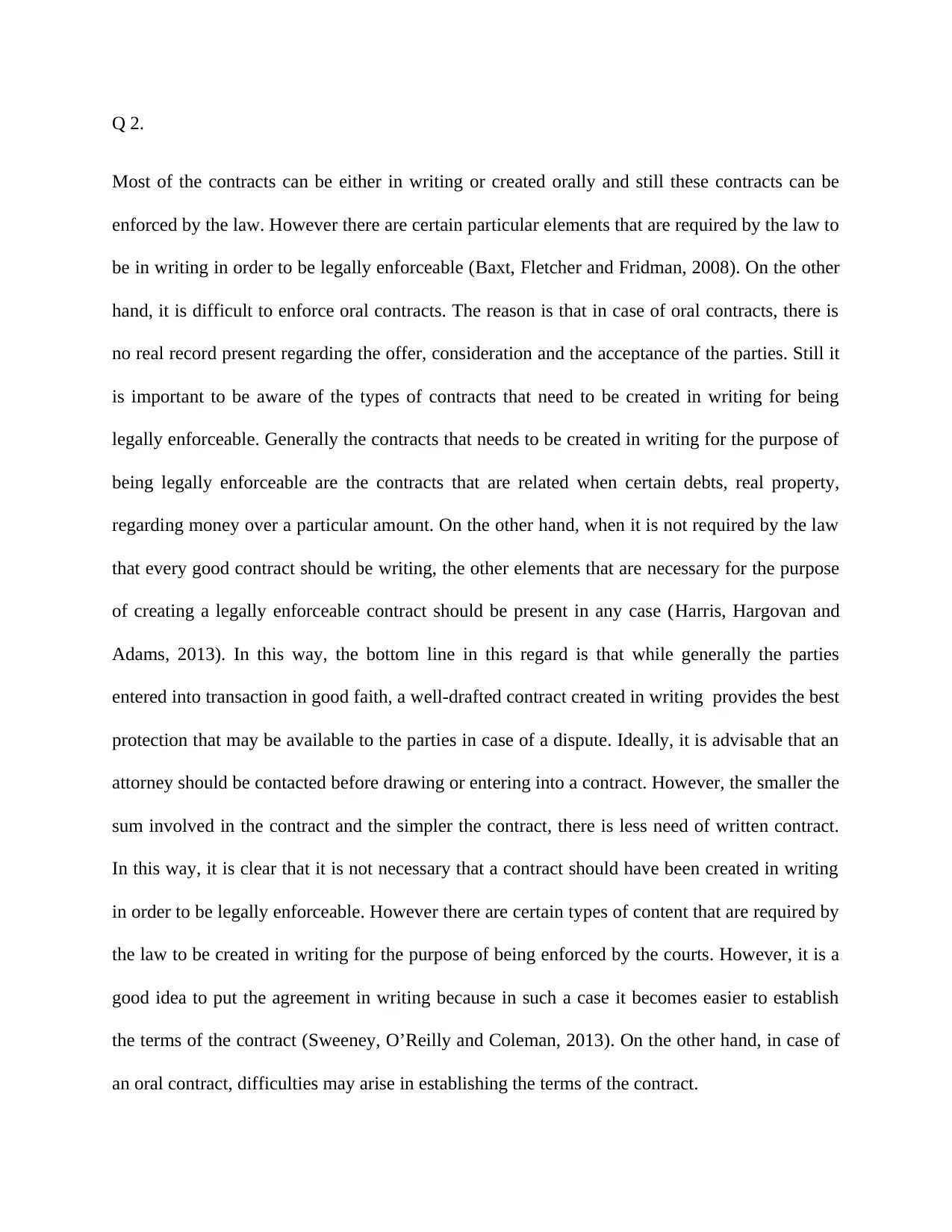
Q 2.
Most of the contracts can be either in writing or created orally and still these contracts can be
enforced by the law. However there are certain particular elements that are required by the law to
be in writing in order to be legally enforceable (Baxt, Fletcher and Fridman, 2008). On the other
hand, it is difficult to enforce oral contracts. The reason is that in case of oral contracts, there is
no real record present regarding the offer, consideration and the acceptance of the parties. Still it
is important to be aware of the types of contracts that need to be created in writing for being
legally enforceable. Generally the contracts that needs to be created in writing for the purpose of
being legally enforceable are the contracts that are related when certain debts, real property,
regarding money over a particular amount. On the other hand, when it is not required by the law
that every good contract should be writing, the other elements that are necessary for the purpose
of creating a legally enforceable contract should be present in any case (Harris, Hargovan and
Adams, 2013). In this way, the bottom line in this regard is that while generally the parties
entered into transaction in good faith, a well-drafted contract created in writing provides the best
protection that may be available to the parties in case of a dispute. Ideally, it is advisable that an
attorney should be contacted before drawing or entering into a contract. However, the smaller the
sum involved in the contract and the simpler the contract, there is less need of written contract.
In this way, it is clear that it is not necessary that a contract should have been created in writing
in order to be legally enforceable. However there are certain types of content that are required by
the law to be created in writing for the purpose of being enforced by the courts. However, it is a
good idea to put the agreement in writing because in such a case it becomes easier to establish
the terms of the contract (Sweeney, O’Reilly and Coleman, 2013). On the other hand, in case of
an oral contract, difficulties may arise in establishing the terms of the contract.
Most of the contracts can be either in writing or created orally and still these contracts can be
enforced by the law. However there are certain particular elements that are required by the law to
be in writing in order to be legally enforceable (Baxt, Fletcher and Fridman, 2008). On the other
hand, it is difficult to enforce oral contracts. The reason is that in case of oral contracts, there is
no real record present regarding the offer, consideration and the acceptance of the parties. Still it
is important to be aware of the types of contracts that need to be created in writing for being
legally enforceable. Generally the contracts that needs to be created in writing for the purpose of
being legally enforceable are the contracts that are related when certain debts, real property,
regarding money over a particular amount. On the other hand, when it is not required by the law
that every good contract should be writing, the other elements that are necessary for the purpose
of creating a legally enforceable contract should be present in any case (Harris, Hargovan and
Adams, 2013). In this way, the bottom line in this regard is that while generally the parties
entered into transaction in good faith, a well-drafted contract created in writing provides the best
protection that may be available to the parties in case of a dispute. Ideally, it is advisable that an
attorney should be contacted before drawing or entering into a contract. However, the smaller the
sum involved in the contract and the simpler the contract, there is less need of written contract.
In this way, it is clear that it is not necessary that a contract should have been created in writing
in order to be legally enforceable. However there are certain types of content that are required by
the law to be created in writing for the purpose of being enforced by the courts. However, it is a
good idea to put the agreement in writing because in such a case it becomes easier to establish
the terms of the contract (Sweeney, O’Reilly and Coleman, 2013). On the other hand, in case of
an oral contract, difficulties may arise in establishing the terms of the contract.

⊘ This is a preview!⊘
Do you want full access?
Subscribe today to unlock all pages.

Trusted by 1+ million students worldwide
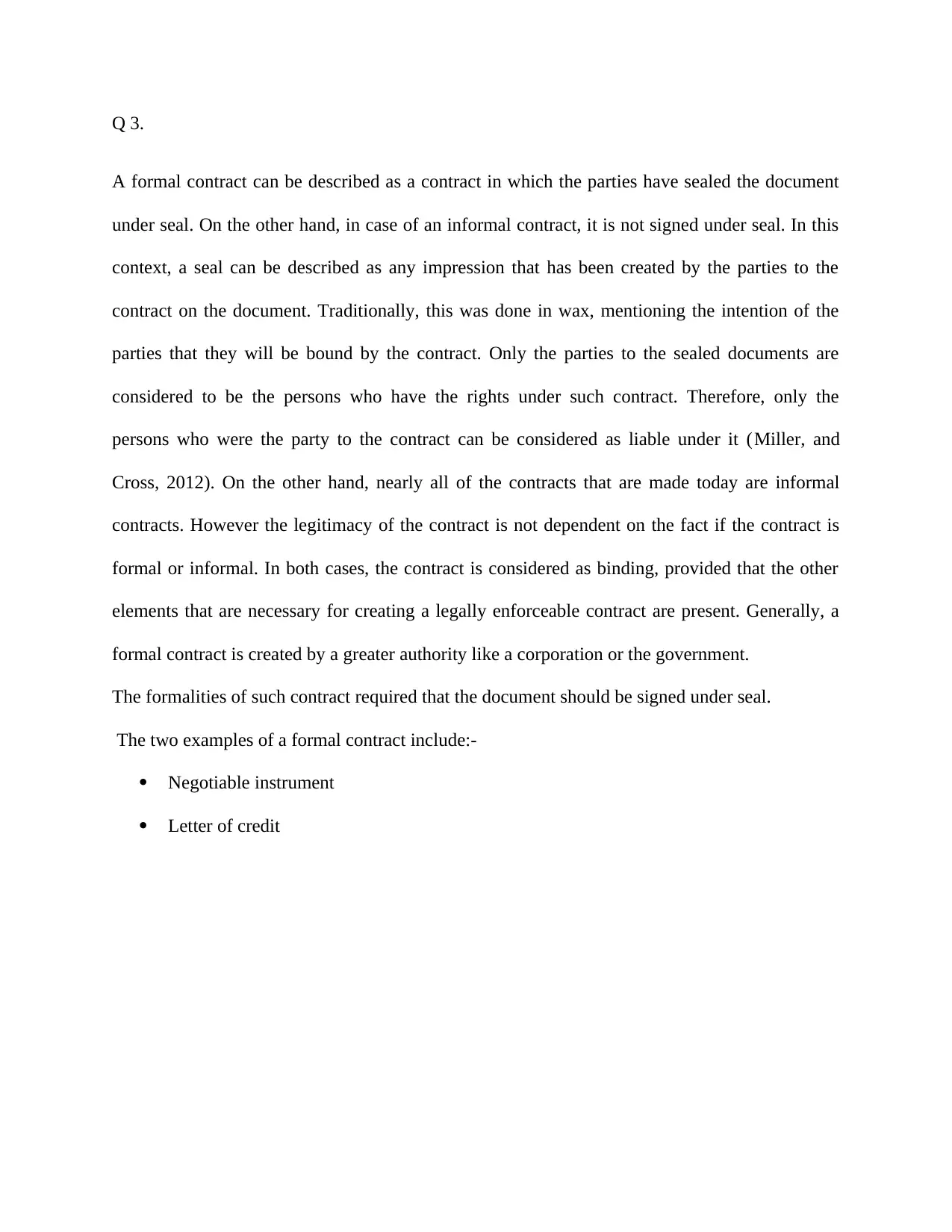
Q 3.
A formal contract can be described as a contract in which the parties have sealed the document
under seal. On the other hand, in case of an informal contract, it is not signed under seal. In this
context, a seal can be described as any impression that has been created by the parties to the
contract on the document. Traditionally, this was done in wax, mentioning the intention of the
parties that they will be bound by the contract. Only the parties to the sealed documents are
considered to be the persons who have the rights under such contract. Therefore, only the
persons who were the party to the contract can be considered as liable under it (Miller, and
Cross, 2012). On the other hand, nearly all of the contracts that are made today are informal
contracts. However the legitimacy of the contract is not dependent on the fact if the contract is
formal or informal. In both cases, the contract is considered as binding, provided that the other
elements that are necessary for creating a legally enforceable contract are present. Generally, a
formal contract is created by a greater authority like a corporation or the government.
The formalities of such contract required that the document should be signed under seal.
The two examples of a formal contract include:-
Negotiable instrument
Letter of credit
A formal contract can be described as a contract in which the parties have sealed the document
under seal. On the other hand, in case of an informal contract, it is not signed under seal. In this
context, a seal can be described as any impression that has been created by the parties to the
contract on the document. Traditionally, this was done in wax, mentioning the intention of the
parties that they will be bound by the contract. Only the parties to the sealed documents are
considered to be the persons who have the rights under such contract. Therefore, only the
persons who were the party to the contract can be considered as liable under it (Miller, and
Cross, 2012). On the other hand, nearly all of the contracts that are made today are informal
contracts. However the legitimacy of the contract is not dependent on the fact if the contract is
formal or informal. In both cases, the contract is considered as binding, provided that the other
elements that are necessary for creating a legally enforceable contract are present. Generally, a
formal contract is created by a greater authority like a corporation or the government.
The formalities of such contract required that the document should be signed under seal.
The two examples of a formal contract include:-
Negotiable instrument
Letter of credit
Paraphrase This Document
Need a fresh take? Get an instant paraphrase of this document with our AI Paraphraser
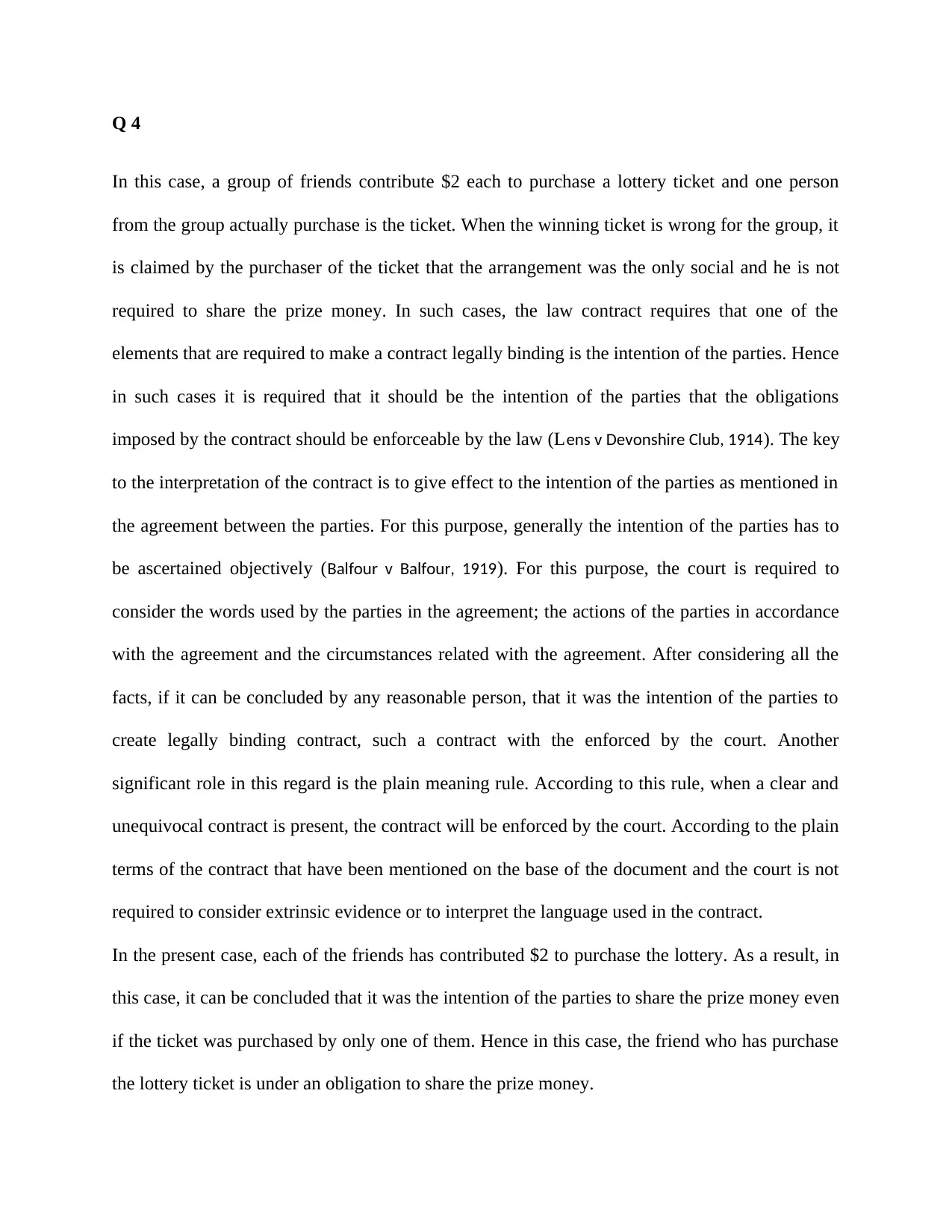
Q 4
In this case, a group of friends contribute $2 each to purchase a lottery ticket and one person
from the group actually purchase is the ticket. When the winning ticket is wrong for the group, it
is claimed by the purchaser of the ticket that the arrangement was the only social and he is not
required to share the prize money. In such cases, the law contract requires that one of the
elements that are required to make a contract legally binding is the intention of the parties. Hence
in such cases it is required that it should be the intention of the parties that the obligations
imposed by the contract should be enforceable by the law (Lens v Devonshire Club, 1914). The key
to the interpretation of the contract is to give effect to the intention of the parties as mentioned in
the agreement between the parties. For this purpose, generally the intention of the parties has to
be ascertained objectively (Balfour v Balfour, 1919). For this purpose, the court is required to
consider the words used by the parties in the agreement; the actions of the parties in accordance
with the agreement and the circumstances related with the agreement. After considering all the
facts, if it can be concluded by any reasonable person, that it was the intention of the parties to
create legally binding contract, such a contract with the enforced by the court. Another
significant role in this regard is the plain meaning rule. According to this rule, when a clear and
unequivocal contract is present, the contract will be enforced by the court. According to the plain
terms of the contract that have been mentioned on the base of the document and the court is not
required to consider extrinsic evidence or to interpret the language used in the contract.
In the present case, each of the friends has contributed $2 to purchase the lottery. As a result, in
this case, it can be concluded that it was the intention of the parties to share the prize money even
if the ticket was purchased by only one of them. Hence in this case, the friend who has purchase
the lottery ticket is under an obligation to share the prize money.
In this case, a group of friends contribute $2 each to purchase a lottery ticket and one person
from the group actually purchase is the ticket. When the winning ticket is wrong for the group, it
is claimed by the purchaser of the ticket that the arrangement was the only social and he is not
required to share the prize money. In such cases, the law contract requires that one of the
elements that are required to make a contract legally binding is the intention of the parties. Hence
in such cases it is required that it should be the intention of the parties that the obligations
imposed by the contract should be enforceable by the law (Lens v Devonshire Club, 1914). The key
to the interpretation of the contract is to give effect to the intention of the parties as mentioned in
the agreement between the parties. For this purpose, generally the intention of the parties has to
be ascertained objectively (Balfour v Balfour, 1919). For this purpose, the court is required to
consider the words used by the parties in the agreement; the actions of the parties in accordance
with the agreement and the circumstances related with the agreement. After considering all the
facts, if it can be concluded by any reasonable person, that it was the intention of the parties to
create legally binding contract, such a contract with the enforced by the court. Another
significant role in this regard is the plain meaning rule. According to this rule, when a clear and
unequivocal contract is present, the contract will be enforced by the court. According to the plain
terms of the contract that have been mentioned on the base of the document and the court is not
required to consider extrinsic evidence or to interpret the language used in the contract.
In the present case, each of the friends has contributed $2 to purchase the lottery. As a result, in
this case, it can be concluded that it was the intention of the parties to share the prize money even
if the ticket was purchased by only one of them. Hence in this case, the friend who has purchase
the lottery ticket is under an obligation to share the prize money.
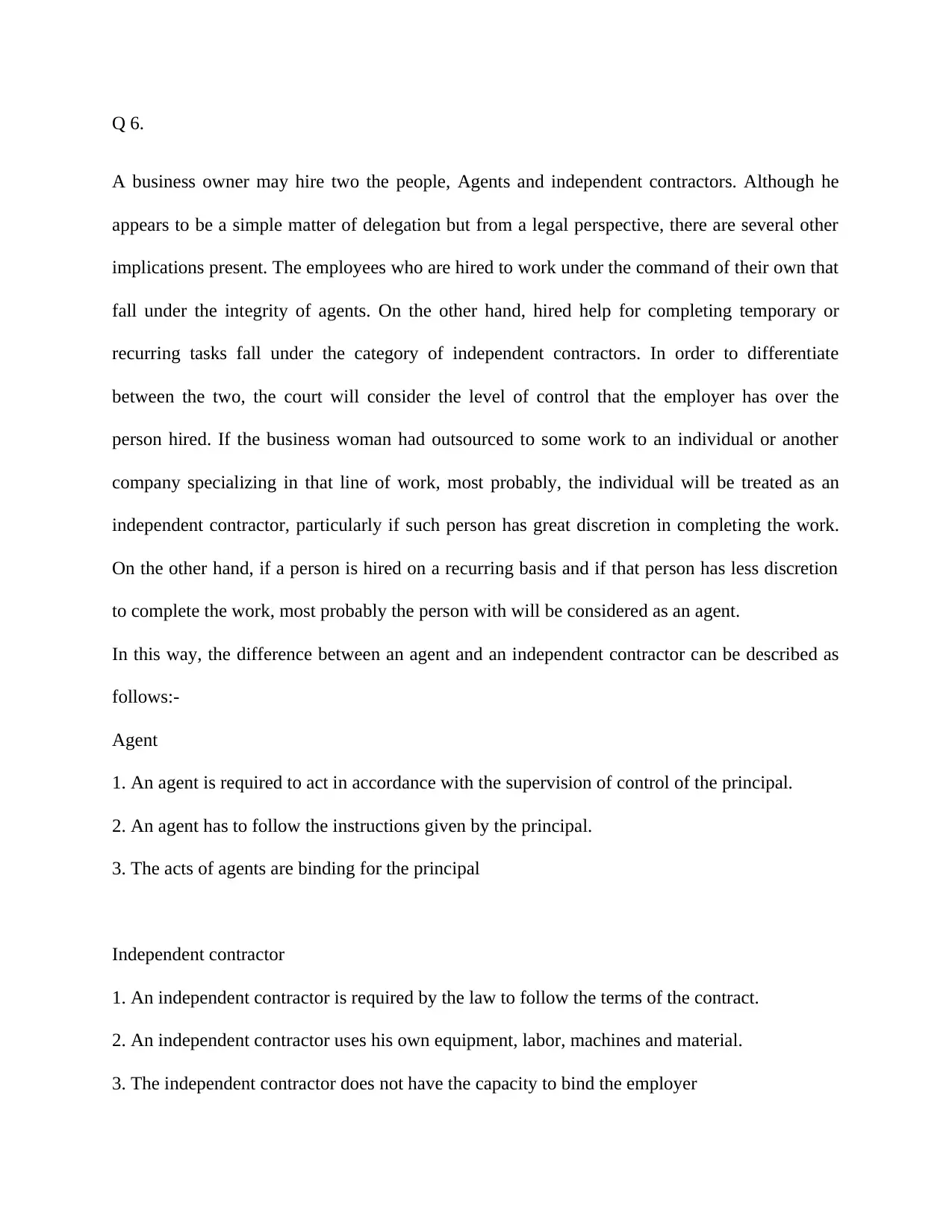
Q 6.
A business owner may hire two the people, Agents and independent contractors. Although he
appears to be a simple matter of delegation but from a legal perspective, there are several other
implications present. The employees who are hired to work under the command of their own that
fall under the integrity of agents. On the other hand, hired help for completing temporary or
recurring tasks fall under the category of independent contractors. In order to differentiate
between the two, the court will consider the level of control that the employer has over the
person hired. If the business woman had outsourced to some work to an individual or another
company specializing in that line of work, most probably, the individual will be treated as an
independent contractor, particularly if such person has great discretion in completing the work.
On the other hand, if a person is hired on a recurring basis and if that person has less discretion
to complete the work, most probably the person with will be considered as an agent.
In this way, the difference between an agent and an independent contractor can be described as
follows:-
Agent
1. An agent is required to act in accordance with the supervision of control of the principal.
2. An agent has to follow the instructions given by the principal.
3. The acts of agents are binding for the principal
Independent contractor
1. An independent contractor is required by the law to follow the terms of the contract.
2. An independent contractor uses his own equipment, labor, machines and material.
3. The independent contractor does not have the capacity to bind the employer
A business owner may hire two the people, Agents and independent contractors. Although he
appears to be a simple matter of delegation but from a legal perspective, there are several other
implications present. The employees who are hired to work under the command of their own that
fall under the integrity of agents. On the other hand, hired help for completing temporary or
recurring tasks fall under the category of independent contractors. In order to differentiate
between the two, the court will consider the level of control that the employer has over the
person hired. If the business woman had outsourced to some work to an individual or another
company specializing in that line of work, most probably, the individual will be treated as an
independent contractor, particularly if such person has great discretion in completing the work.
On the other hand, if a person is hired on a recurring basis and if that person has less discretion
to complete the work, most probably the person with will be considered as an agent.
In this way, the difference between an agent and an independent contractor can be described as
follows:-
Agent
1. An agent is required to act in accordance with the supervision of control of the principal.
2. An agent has to follow the instructions given by the principal.
3. The acts of agents are binding for the principal
Independent contractor
1. An independent contractor is required by the law to follow the terms of the contract.
2. An independent contractor uses his own equipment, labor, machines and material.
3. The independent contractor does not have the capacity to bind the employer
⊘ This is a preview!⊘
Do you want full access?
Subscribe today to unlock all pages.

Trusted by 1+ million students worldwide
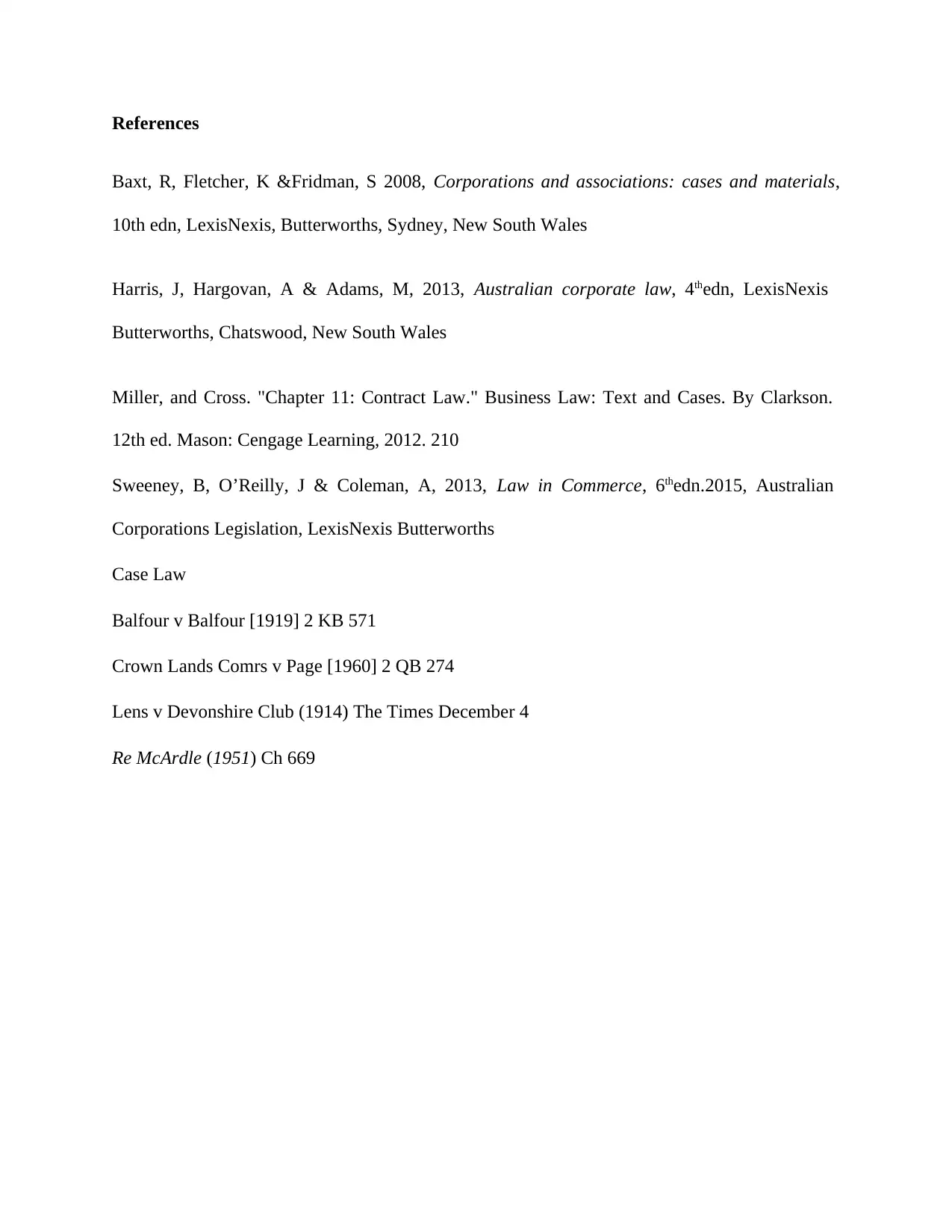
References
Baxt, R, Fletcher, K &Fridman, S 2008, Corporations and associations: cases and materials,
10th edn, LexisNexis, Butterworths, Sydney, New South Wales
Harris, J, Hargovan, A & Adams, M, 2013, Australian corporate law, 4thedn, LexisNexis
Butterworths, Chatswood, New South Wales
Miller, and Cross. "Chapter 11: Contract Law." Business Law: Text and Cases. By Clarkson.
12th ed. Mason: Cengage Learning, 2012. 210
Sweeney, B, O’Reilly, J & Coleman, A, 2013, Law in Commerce, 6thedn.2015, Australian
Corporations Legislation, LexisNexis Butterworths
Case Law
Balfour v Balfour [1919] 2 KB 571
Crown Lands Comrs v Page [1960] 2 QB 274
Lens v Devonshire Club (1914) The Times December 4
Re McArdle (1951) Ch 669
Baxt, R, Fletcher, K &Fridman, S 2008, Corporations and associations: cases and materials,
10th edn, LexisNexis, Butterworths, Sydney, New South Wales
Harris, J, Hargovan, A & Adams, M, 2013, Australian corporate law, 4thedn, LexisNexis
Butterworths, Chatswood, New South Wales
Miller, and Cross. "Chapter 11: Contract Law." Business Law: Text and Cases. By Clarkson.
12th ed. Mason: Cengage Learning, 2012. 210
Sweeney, B, O’Reilly, J & Coleman, A, 2013, Law in Commerce, 6thedn.2015, Australian
Corporations Legislation, LexisNexis Butterworths
Case Law
Balfour v Balfour [1919] 2 KB 571
Crown Lands Comrs v Page [1960] 2 QB 274
Lens v Devonshire Club (1914) The Times December 4
Re McArdle (1951) Ch 669
1 out of 7
Related Documents
Your All-in-One AI-Powered Toolkit for Academic Success.
+13062052269
info@desklib.com
Available 24*7 on WhatsApp / Email
![[object Object]](/_next/static/media/star-bottom.7253800d.svg)
Unlock your academic potential
Copyright © 2020–2025 A2Z Services. All Rights Reserved. Developed and managed by ZUCOL.




